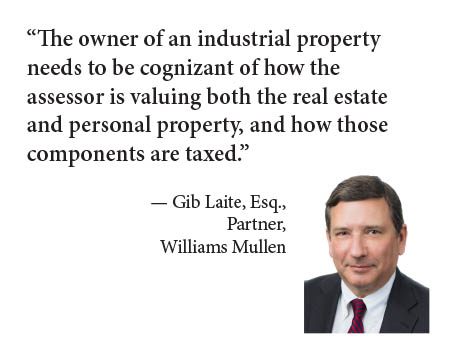North Carolina taxes both real estate and personal property, but differing valuation schedules and processes for the two types can lead to confusion and inflated tax bills for industrial property owners. Understanding how assessors value industrial properties can help those taxpayers detect issues and contest unfair assessments.
Dual processes
North Carolina requires assessors to revalue real property at least every eight years. The value as of Jan. 1 of the valuation year then remains constant until the next valuation, unless specified changes in the property occur to trigger a change in the assessment. Many counties revalue every four years, and a few, even more frequently.
Assessors use a market analysis to determine real property’s taxable or fair market value. This involves applying one or more of the three valuation approaches: cost, comparable sales, or income.
The state requires annual valuation of personal property based on installed cost, which is subject to the applicable trending and depreciation schedules. For the most part, taxing authorities rely on the taxpayer’s annual business personal property listing to determine what items of personal property are present, the installed cost, and the trending and depreciation schedule applied. The counties follow schedules for auditing the property tax listings, and most disputes that arise stem from these audits.
With industrial real estate, the two tax schemes can create conflicts based on property components that could be considered either real estate or personal property, depending on circumstances. For example, reinforced foundations or specialized wiring for unique machinery could be considered a real estate improvement, thereby adding value to the real estate, or they could be considered personal property subject to depreciation and trending.
Although the tax rate applied is the same for both real estate and personal property, categorization can significantly affect taxable value. Real property improvements enhance market value on a more permanent basis, while personal property value is generally presumed to decline because of annual trending and depreciation.
And of course, no one wants to be taxed twice on the same property: once by having a component or improvement included in the real estate value, and again by having it taxed as personal property.
Defining characteristics
How can a taxpayer determine what is real and what is personal in their industrial property? Generally, personal property items are movable and not permanently affixed to real estate. An issue of intent arises, however, if the item can be removed but not without causing serious damage to the real estate.
A rule of thumb in the North Carolina Department of Revenue’s Personal Property Appraisal and Assessment Manual instructs assessors to classify all property and investment necessary for the operation of machinery and equipment as personal. Examples are wiring, venting, flooring, special climate control, conveyors, boilers and furnaces, dock levelers, and equipment foundations. Stated another way, property used as part of a process, or that is in place to support equipment, is generally personal property.
On the other hand, Department of Revenue staff regard items in the plant for lighting, air handling and plumbing for human comfort to be part of the real estate. The department’s appraisal and assessment manual includes an extensive chart, and each county’s published schedule of values may also provide a helpful listing.
It is often difficult to know whether the county has included what could be classified as personal property in its calculation of real property value. Regardless, if the taxpayer has not listed such items on the annual personal property submissions, it will be difficult to argue after the fact that they should have been excluded from the real estate value.
Taxpayer strategies
Taxpayers can argue for a reduced assessment by identifying personal property items improperly classified as real property in the assessor’s calculations and seeking to have them treated as personal property subject to trending and depreciation. Knowing where to look for personal items will help the property owner in this task.
A critical item to be generally classified as personal property is any leasehold improvement. Leasehold improvements often look like real estate but are owned and controlled by the tenant for the lease term. These are items the tenant paid for and received under terms of the lease or other contract, and were installed for the tenant’s use. Leasehold items almost always facilitate the tenant’s business.
In deciding whether these items are real or personal property, the taxing authority will apply a test akin to a traditional fixture analysis, determining the manner of affixation, whether the item can be removed without serious damage, and whether it is intended to remain permanent. In the end, the assessor will apply a “totality of the circumstances” test, including the lease terms.
The tenant – as the owner of the leasehold improvements – is required to list those items as personal property. The landlord should monitor the tenant’s personal property submissions to ensure that all tenant improvements are being listed. This will help to avoid leasehold items being considered as part of the current real estate valuation.
Unlike a traditional fixture analysis, and dependent on the lease terms, the improvements may be taxed to the tenant during the term of the lease. When the improvements are left to the landlord at the end of the lease term, the taxing authority will need to consider assigning any remaining value to the real estate.
The owner of an industrial property needs to be cognizant of how the assessor is valuing both the real estate and personal property, and how those components are taxed. This requires knowing what improvements are included in the valuation of the real property as of the valuation date, and tracking the annual personal property tax listings, especially those submitted by a tenant. Finally, taxpayers must be timely in correcting any erroneous assumptions or listings.
— Gib Laite is a partner in the law firm Williams Mullen, the North Carolina member of American Property Tax Counsel (APTC), the national affiliation of property tax attorneys. He can be reached at glaite@williamsmullen.com.


